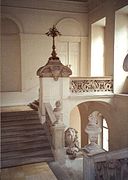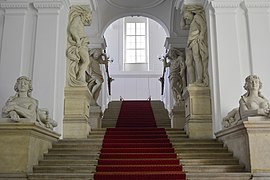Johann Georg Haresleben

Johann Georg Haresleben (* 1671 in Kühnring near Eggenburg , Lower Austria ; † July 24, 1716 in Kaisersteinbruch , Hungary, today Burgenland) was an Austrian master stonemason of the Baroque era .
Haresleben stonemason family from Eggenburg

Three sons of Alexander and Maria Haresleben learned the stonemasonry: Michael, Thomas and Hans Georg. The Haresleben were a successful Eggenburg stonemason family, the uncle Adam Haresleben († 1683) became master builder in St. Stephen's Cathedral in 1654 after Hans Herstorffer , 1656 and 1677 headmaster of the Viennese building works, and brother Thomas Haresleben also held the office of chief master in Vienna in 1712 and 1717 inside. Hans Georg was arrested by the Eggenburg master Wolfgang Steinböck , and in 1689 he was acquitted.
The Eggenburger Stone, now called Zogelsdorfer Stone , a sculptural stone that is easy to work with, was one of the most important Viennese building stones. In the Hofburg , the Viennese city palaces and garden palaces, in the churches, etc., he contributed to the splendor of these buildings. The hard to very hard stone from Kaisersteinbruch was also used there. Towards the end of the 17th century, this connection was also strengthened in terms of personnel, which meant that the Eggenburg journeymen took over the Imperial Quarry through a widow marriage .
- Marriage to the Ferrethi clan after Kaisersteinbruch
Hans Georg Haresleben was one of these pioneers at the age of 25. He married Catharina Ferrethin, a 56-year-old widow, on November 18, 1696. Court stone mason, Ambrosius Ferrethi , from Castiglione d'Intelvi in the Como district , had died. His wife Catharina had entered him as master craftsman in 1699 in the land register with two quarries and three houses.
Tax list 1699
In the tax list of 1699 Haresleben was entered with a quarry, two houses, six cows and three horses.
Schönbrunn Castle
In 1569 the already dilapidated Katterburg hunting lodge came into imperial possession. The actual building history of Schönbrunn Palace began in 1695 with the creation of the garden by Jean Trehet. The construction project of Johann Bernhard Fischer von Erlach is documented for the first time safely for the following year. The driving force behind the company was Obersthofmeister Graf Salm, the educator Joseph I , who let Fischer report personally in order to eliminate the bureaucracy of the building authorities. The planned structural extensions meant an upgrading of the hunting lodge in function, rank and form to a veritable residence in view of the impending wedding of Joseph and the resulting enlarged court.
In 1697 the Viennese masters Veith Steinböck and Thomas Schilck, both from Eggenburg , master Georg Deprunner from Loretto (then Hungary ) and master Hans Georg Haresleben from Kaisersteinbruch received stonemason orders . The 2,220 guilders demanded by Haresleben ... because of his stone carving work delivered to Schönbrunn were not paid during his lifetime, nor did his widow, re-married Maria Regina Synn, daughter of Maria Elisabetha Hügelin , wrote the most humble, obedient requests for the most gracious ordinance .
Bohemian Court Chancellery , Löwenstiege
Lower Belvedere , garden side
Salva Guardia privilege for Kaisersteinbruch
Emperor Charles VI. renewed and confirmed on December 5, 1712 the privilege of exemption from military billeting for the masters Johann Georg Haresleben, Sebastian Regondi , Johann Paul Schilck , Elias Hügel , Johann Baptist Kral and Simon Sasslaber .
Independent quarter drawer for the imperial quarry in 1714
On December 20, 1714, the Kaiser approved and renewed the independent quarter store in Kaisersteinbruch.
Major order Karlskirche
He was on the way to becoming the first in the Kaisersteinbrucher Brotherhood , which he had achieved with the stonemason contract for the construction of the Imperial Church , the Karlskirche . This building symbolized the baroque imperial art in Vienna. He was assigned a position within the Holy Roman Empire , such as was assigned to St. Peter's Basilica in Rome for all of Christianity.
death
But Haresleben died on July 24th, 1716, and his co-master Elias Hügel took over the overall management of the quarry and thus established his rise.
His epitaph was in the Kaisersteinbruch church . The inscription reads:
STANDING SILENT YOU TRAVELING / SEE WHAT THIS STONE SHOWS / UNDER WHICH IS HIDDEN / WHAT'S HAY IS HAINT OR TOMORROW / THE LORD GOD'S BLESSED / HONORED VEST OF MR.JOHANN GEORG HARISLEBEN / AFTER HEU VILLA IN THE YEAR XXX YEAR OLD / HAS HE ... the remaining 9 lines can no longer be deciphered. Last 1716.
Master Haresleben's stonemason mark is carved on the Kaisersteinbruch local stone by the sculptor Alexandru Ciutureanu .
Works
- 1697–1703: Schönbrunn Palace
- 1699–1706: Schönborn-Batthyány Palace
- 1709–1713: Prugg Castle in Bruck an der Leitha for Aloys Thomas Raimund von Harrach
- 1709–1714: Bohemian court chancellery
- from 1710: Parish church of Pottendorf
- from 1712: Palais Trautson
- 1713–1716: Daun-Kinsky Palace
- from 1714: Lower Belvedere Palace , more a garden house than a palace, the masters had to plan the future order for the upper palace.
- from 1715: Karlskirche
Archival material
- Archive Mosonmagyaróvár : Copy of the Kaiserl. Document 1712 . No. 36/1494.
- Vienna City and State Archives : Steinmetzakten .
- Hofkammerarchiv : Court Pay Office books: “Construction of the Karlskirche” . 1715/1716. Camerale payment office books: "Schönbrunn Palace".
- Heiligenkreuz Abbey Archive: Church books, registers .
- Count of Harrach's family archive : Prugg Castle in Bruck an der Leitha .
literature
- Otto E. Plettenbacher: History of the stonecutters of Vienna in the 17th century. An economic and cultural historical as well as sociological investigation. Price list 1688, set order of the stone carvings . Dissertation, University of Vienna 1960.
- Helmuth Furch : In: Messages of the Museum and Culture Association Kaisersteinbruch .
- The Haresleben family . No. 3, 1990, pp. 6-13. ISBN 978-3-9504555-3-3 .
- Hans Georg Haresleben, Heiligenkreuz subject and master stonemason in quarry . No. 36, 1995, pp. 10-40.
- Helmuth Furch: Elias Hügel, court stone mason, 1681–1755 . Kaisersteinbruch 1992. ISBN 978-3-9504555-2-6 .
- Hellmut Lorenz and Wilhelm Georg Rizzi: Johann Lucas von Hildebrandt's palace for Count Daun . and Luigi A. Ronzoni: The Sculpture Equipment of the Palais Daun-Kinsky . In: Palais Daun-Kinsky . Vienna-Freyung. Vienna 2001, p. 42 and p. 117/118.
- Helmuth Furch: Historical Lexicon Kaisersteinbruch . 2 volumes. Museum and cultural association, Kaisersteinbruch 2002–2004. ISBN 978-3-9504555-8-8 .
- Burghard Gaspar: The "White Stone of Eggenburg". The Zogelsdorf sand-lime brick and its masters . In: The Waldviertel . 44, 1995, No. 4, ISSN 0259-8957 , pp. 331-367.
Web links
- Helmuth Furch 1995, Graefl. Harrachsche Archives and the Kaiser Quarry
- Helmuth Furch 2002, Historisches Lexikon Kaisersteinbruch Volume 1 , 2004, Volume 2
Individual evidence
- ^ Testament of Catharina Hareslebin dated August 14, 1707, in communications from the Museum and Culture Association Kaisersteinbruch, No. 3, Advent 1990, p. 10f.
- ^ Archives Mosonmagyaróvár , List of taxpayers in quarry 1699
- ↑ URL: https://regiowiki.at/index.php?title=Maria_Regina_S%C3%BCnnin&oldid=157781
| personal data | |
|---|---|
| SURNAME | Haresleben, Johann Georg |
| BRIEF DESCRIPTION | Austrian master stonemason of the Baroque |
| DATE OF BIRTH | 1671 |
| PLACE OF BIRTH | Kühnring |
| DATE OF DEATH | July 24, 1716 |
| Place of death | Kaisersteinbruch |









